
Polycrystalline vs. Monocrystalline RV Solar Panels
If you’re considering installing solar on your RV, you may have noticed that solar panels are available as both polycrystalline and monocrystalline. What is the difference between the two, and which one is better for an RV solar system?
Monocrystalline and polycrystalline solar panels both collect solar energy to transform into electricity for your RV. Both are made of silicon. The main difference between the two types of solar panels is the kind of silicon that’s used; A polycrystalline solar cell is made from many silicon chips melted together, while a monocrystalline solar cell is made from a large, single crystal of silicon.
Polycrystalline Solar Panels
The advantage of a polycrystalline solar panel is it’s less expensive. However, a polycrystalline solar panel is less efficient than a monocrystalline panel, meaning it produces less energy. The process of melting together many fragments of silicon means a lower efficiency compared to a monocrystalline solar panel.
Monocrystalline Solar Panels
The main advantage of monocrystalline solar panels is increased efficiency, which means they’ll produce more power. Monocrystalline solar panels are considered by many to be the best type of solar panel. Since the monocrystalline solar cells are made from a single silicon crystal, monocrystalline panels are more efficient than polycrystalline solar panels. However, they are also more expensive.
What is the Difference in Efficiency?
Generally, a monocrystalline solar panel will convert about 20% or more of the sun’s energy into electric power, compared to around 15% for polycrystalline panels. However, this doesn’t always mean that every monocrystalline solar panel will perform better than every polycrystalline panel.
The lower efficiency of polycrystalline panels may mean you’ll need to install bigger, or more panels on your roof compared to monocrystalline solar panels.
However, the angle of the sun will also influence the efficiency of any type of solar panel; all solar panels need direct sunlight to produce the maximum amount of power.
The Price Difference
The price of solar panels keeps going down across the board, no matter which type you choose for your RV. In fact, the price difference between a 100-watt monocrystalline solar panel and a cheaper 100-watt polycrystalline panel may only be $10-20. Of course, if you’re planning to install a lot of panels, polycrystalline may be worth it. But the typical solar installation on an RV is around 400 watts, so you may save less than $100 to go with the cheaper and less efficient polycrystalline panels.
As it stands, there are more options for monocrystalline solar panels on websites like Amazon than there are for polycrystalline panels. Likewise, the price difference between a 100-watt monocrystalline panel and a 100-watt polycrystalline panel may only be $10. Therefore, installing monocrystalline panels on your RV seems to make the most sense.
Related Video:
